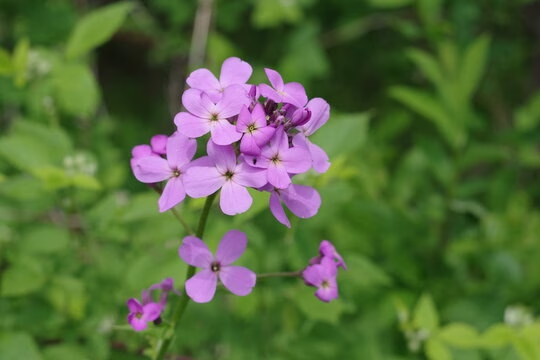
Hesperis Matronalis
Botanical Name
:
Hesperis matronalis
Plant Type
:
Herbaceous biennial
Seasons
:
Late spring to early summer (blooms in the second year).
Sun Level
:
4–6 hours of full sun to partial shade daily.
Ideal Soil Temperature for Planting
:
60–70°F (15–21°C)
Soil Type
:
Well-drained soil. Can thrive in clay, loam, or sand.
Germination
:
14–21 days at 60–70°F (15–21°C); seeds may benefit from cold stratification.
P.H. Level
:
Neutral to slightly alkaline (6.5–7.5)
Water/Irrigation
:
Keep soil moist but not waterlogged and water regularly during dry seasons.
Fertilization
:
Light feeding in spring with compost or a balanced organic fertilizer; avoid over-fertilizing
Habit
:
Forms a mound of foliage initially followed by upright stems bearing flowers the next year if grown as a biennial. Stems are hairy and multi-branched.
Final Plant Height
:
24–36 inches (60–90 cm)
Spread
:
12–24 inches (30–60 cm)
Spacing
:
12–24 inches (30–60 cm)
Flowers
:
Clusters of fragrant, four-petaled flowers in shades of purple, pink, or white; blooms in late spring to early summer.
Attracts
:
Moths (especially at night, due to their fragrance), butterflies, and bees.
Uses
:
Cottage gardens, wildflower meadows, borders, and cut flowers.
Companions
:
Foxgloves, Columbines, and other cottage garden plants.
Pruning
:
Deadhead spent flowers to prevent self-seeding; cut back after flowering to maintain tidiness.
Toxicity
:
Non-toxic to humans and pets.
Pests
:
Aphids and flea beetles.
Diseases
:
Powdery mildew and downy mildew (if conditions are too humid).
Botanical Name
:
Hesperis matronalis
Plant Type
:
Herbaceous biennial
Seasons
:
Late spring to early summer (blooms in the second year).
Sun Level
:
4–6 hours of full sun to partial shade daily.
Ideal Soil Temperature for Planting
:
60–70°F (15–21°C)
Soil Type
:
Well-drained soil. Can thrive in clay, loam, or sand.
Germination
:
14–21 days at 60–70°F (15–21°C); seeds may benefit from cold stratification.
P.H. Level
:
Neutral to slightly alkaline (6.5–7.5)
Water/Irrigation
:
Keep soil moist but not waterlogged and water regularly during dry seasons.
Fertilization
:
Light feeding in spring with compost or a balanced organic fertilizer; avoid over-fertilizing
Habit
:
Forms a mound of foliage initially followed by upright stems bearing flowers the next year if grown as a biennial. Stems are hairy and multi-branched.
Final Plant Height
:
24–36 inches (60–90 cm)
Spread
:
12–24 inches (30–60 cm)
Spacing
:
12–24 inches (30–60 cm)
Flowers
:
Clusters of fragrant, four-petaled flowers in shades of purple, pink, or white; blooms in late spring to early summer.
Attracts
:
Moths (especially at night, due to their fragrance), butterflies, and bees.
Uses
:
Cottage gardens, wildflower meadows, borders, and cut flowers.
Companions
:
Foxgloves, Columbines, and other cottage garden plants.
Pruning
:
Deadhead spent flowers to prevent self-seeding; cut back after flowering to maintain tidiness.
Toxicity
:
Non-toxic to humans and pets.
Pests
:
Aphids and flea beetles.
Diseases
:
Powdery mildew and downy mildew (if conditions are too humid).

